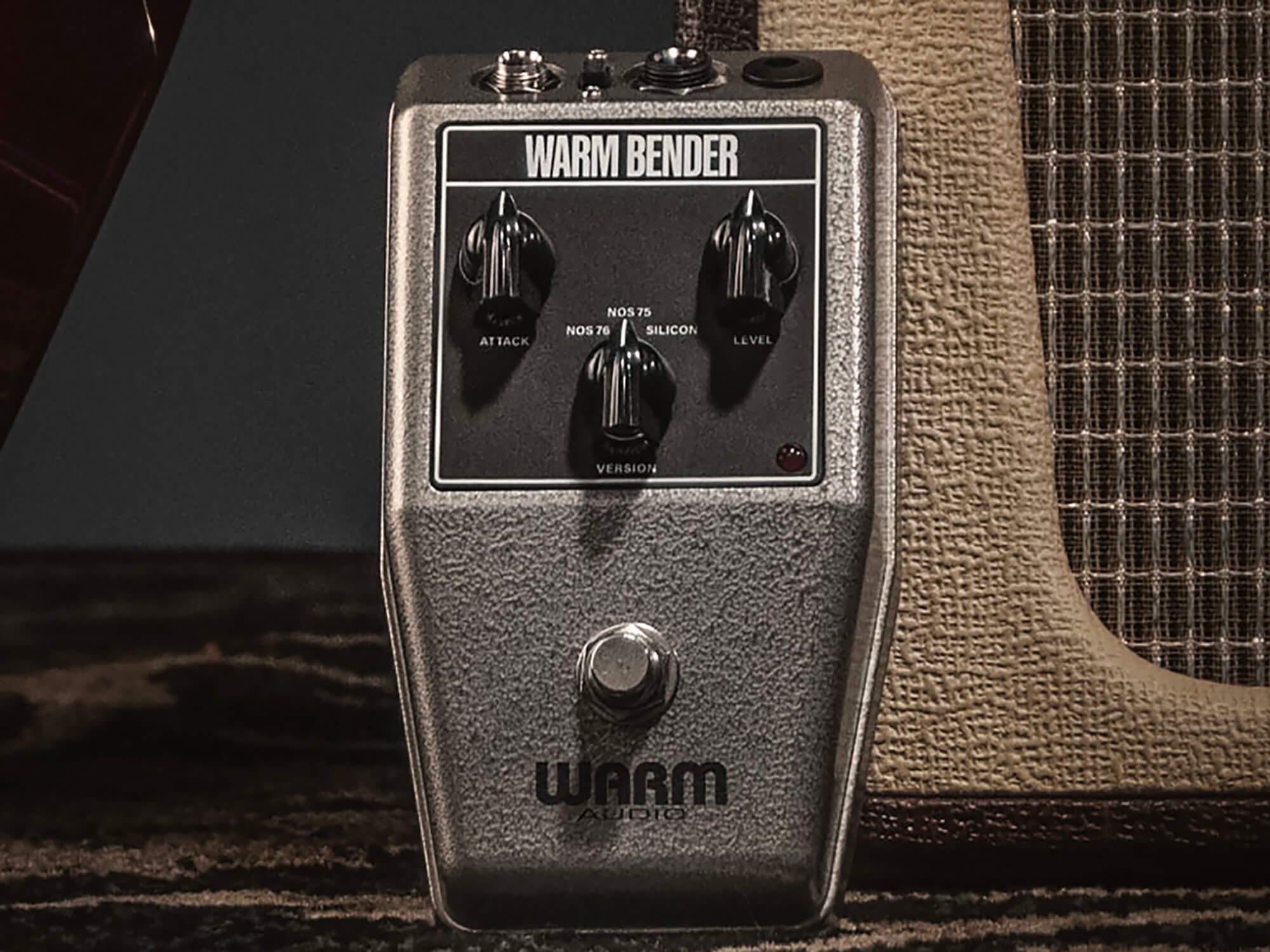Related Tags
Warm Audio Warm Bender review – all the Tone Bending you could need?
With a total of five NOS germanium transistors, three circuits and a sag switch, Warm Audio’s latest ‘faithful’ vintage recreation is offering an absolute fuzzload of options

Warm Audio Warm Bender
Review Overview
Our rating
8
Our verdict
$199/£209, warmaudio.com
It’s that time again – Warm Audio’s cloning vat has been reheated! Thrown in this time are a handful of vintage British fuzz pedal designs, some new-old-stock Germanium transistors and a can of grey hammertone paint. And sliding steaming into the output tray is the freshly minted Warm Bender: it’s a three-mode take on some classic Tone Bender circuits that, as with most Warm Audio pedals, promises vintage mojo at a non-vintage price.
Regardless of what you think of Warm Audio’s approach to, er, ‘faithful’ recreations of pedals new and old, the boutique pedal world has been on the Tone Bender train for a while now – there are plenty of Bender-alikes already on the market, from the large-scale stuff like JHS’ Bender to hand-made options like Seeker Electric’s Bend.
On paper, the Warm Bender aims to split the difference between the two approaches: there’s the very vibey look and the fact that two of the three circuits use germanium transistors rather than SMD silicon ones. But… the pedal is still only £209, and you don’t need to wait a month for it to be built.
Warm Audio is also known for capturing the unique vibe of the enclosure designs of the gear it’s recreating, from thumbscrews to felt. That’s still the case (tee hee) here – while the Warm Bender has three circuit variations, it’s housed in a more compact version of the angled and tapered die-cast Mk 1.5 enclosure, and finished in a similar grey hammertone paint.
When I pop the back off, the component side of the board is sadly facing the inside of the pedal. So there’s no way to have a look at those germanium cans without disassembling the whole thing. But it’s nice to see that the vintage vibes continue within – it’s not quite hand-wired turret board, but there are through-hole components at least, and what appears to be a relatively simple two-layer beige pcb. A quick shoutout to Joe at Gray Bench Electronics, who has actually taken apart the whole thing, so if you’re very curious about the internal construction you can check out his teardown.
But, internals don’t really matter when it gets down to blasting riffs from Zeppelin I. So let’s do some of that. What can Warm Audio bring to the world of Bender-inspired pedals that isn’t already present?

How does the Warm Bender sound?
The Warm Bender has a total of six operating modes: three discrete fuzz circuits chosen by the front rotary switch, and a sag mode which drops the power supply down from a full nine volts to about six for a more compressed and occasionally gated sound. The actual controls for each fuzz are limited to just attack (gain/fuzz) and level – there’s no tone control as you might find on some later Tone Benders.
NOS 76 Mode
This is a two-transistor circuit using one OC76 and one SFT337 – both germanium. Warm Audio just says that it’s voiced after “early” Bender sounds – but given that just two transistors are in use, we can take that to mean Mk 1.5. It absolutely nails that sound and feel, particularly the chewy pick attack. The overall voicing is very midrange-heavy and smooth, too – it’s a great combination with a cleaner Fender-voiced amplifier.
It’ll take you straight to the world of mid-60s British blues rock leads if you need, with good amounts of sustain – but there’s also a surprising amount of clarity when digging into some chords. In short: it’s a Tone Bender! It eats up bluesy licks and stompy riffs in a way that makes it obvious why the sound has stuck around for decades.
Being a two-transistor circuit with a good number of similarities to a Fuzz Face, the NOS 76 mode rewards me the most when I roll back the volume control. Doing so (provided the pedal is first in the chain) gives me a really unique clean sound: sparkly and responsive, but sprinkled with just enough grit to remind me this is still a fuzz, and things are a knob-turn away from getting hairy again.
Engaging the sag switch here doesn’t have a massive effect – things are a little more spluttery and compressed, and the cleanup happens faster, but it’s not a massive change to the sound. It’s a nice variation to have, however, the kind that will help you sit the pedal in a wider signal chain.

NOS 75 mode
This mode uses three OC75 transistors to recreate the sounds of a Mk II Tone Bender. In comparison to the Mk 1.5 mode, things are significantly more compressed, dark and aggressive. Anything more complex than a power chord gets really crunched up by the NOS 75 circuit, much more so than its two-transistor counterpart. It’s not a bad sound by any means – rhythm playing is still on the table, but mainly for hammering out those aforementioned Zeppelin I riffs. The appeal here is power rather than complexity, and, having accepted that, playing it is a blast.
In this mode, I do find that the sag control is best avoided – things are already very compressed, and dropping the voltage only really serves to make things more so. It’s maybe a sound that has a few specific use cases, but for my money it tips the balance from musically squished to just plain undynamic and flat.
Silicon Mode
While the voicing of both germanium modes is quite smooth, the silicon mode is a little more biting. It’s still recognisably Tone Bender-y, however, less vocal in its midrange, and the attack is sharper. Dig in with a pick in the germanium modes, your sound crumples like an origami swan under the wheels of a lorry before reassembling itself once the circuit’s gotten over the shock of the transient. Here, though, the front of the note is more resilient – the bite as you dig stays a bit more intact. Hence, faster playing is a little more articulate.
Engaging the sag control on the silicon mode and things get properly gated for the first time, which is always fun. Given the generally more jagged character of the fuzz here too, it’s a sound that really opens up the pedal to more aggressive approaches – a little wave from Jack White in a very Jimmy Page-heavy pedal.
Is the Warm Bender worth buying?
It’s undeniable that the Warm Bender is much more pedalboard-friendly than a full-sized vintage Tone Bender (or three!), but there are still some quirks to its format. The proximity of the audio jacks and the starve switch makes for quite a cramped situation when plugged in, especially when using pancake jacks – and the rightmost jack is power, rather than audio, which could lead to some finicky cable management. More positively, its low-profile feet make it easily attached to a ’board.
Build quality is, however, top-notch – when popping the back off, the sheer thickness of the die-cast enclosure is impressive. Through-hole wiring is reassuring from a repairability standpoint, and it’s also cool to see two little walls keeping the footswitch from rotating, which can help stop the nut getting loose over time.

Who is the Warm Audio Warm Bender for?
Really, if you’ve ever been Tone Bender curious – or are just a fan of vintage fuzz at all – then you’ll find something to like in the Warm Bender. Importantly, however, it doesn’t really do anything to modernise the format. If you can’t be bothered with impedance sensitivity or the lack of any tone control, then it won’t help you – but making the platform more sonically accessible isn’t really the goal here.
Instead, Warm Audio has packed in three great vintage-style fuzz circuits into a relatively pedalboard-friendly and very roadworthy package, at a price that will not require selling your car.
Warm Audio Warm Bender alternatives
There are endless boutique recreations of Tone Bender circuits out there, and you can always keep your eye on the Marcari’s Colorsound storefront for the “real deal” (£499). But, keep in mind that the Warm Bender does offer three dual-mode fuzzes for the same price as, say, the single two-mode circuit within the JHS Bender ($179/£179). In terms of true affordable alternatives, it could be argued that it is the affordable alternative.
But, if you’re not fussed about vintage accuracy, the Keeley Fuzz Bender ($149/£159) is a good affordable germanium fuzz option. It’s roughly Tone Bender-inspired, and its EQ control is powerful enough to approximate a good number of different fuzz voicings.
